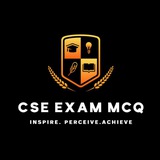Forwarded from Upsc prelims MCQ
Consider the following statements:
1. The Gupta period is often called the ‘Golden Age’ of ancient India
2. The Gupta rulers issued gold coins
1. The Gupta period is often called the ‘Golden Age’ of ancient India
2. The Gupta rulers issued gold coins
Forwarded from Upsc prelims MCQ
Which one of the following is correct in respect of the above statements?
Anonymous Quiz
35%
Both Statement-I and Statement-II are correct and Statement-II explains Statement-I
48%
Both Statement-I and Statement-II are correct, but Statement-II does not explain Statement-I
15%
Statement-I is correct, but Statement-II is incorrect
1%
Statement-I is incorrect, but Statement-II is correct
Forwarded from Upsc prelims MCQ
The people of Harappa and Mohenjodaro culture belonged to the
Anonymous Quiz
10%
New Stone Age
34%
Copper Age
44%
Chalcolithic Age
12%
Iron Age
Forwarded from Upsc prelims MCQ
Consider the weapons :
1. Swords
2. Arrows
3. Spears
4. Bows
5. Daggers
1. Swords
2. Arrows
3. Spears
4. Bows
5. Daggers
Forwarded from Upsc prelims MCQ
Which of the weapons given above are known to Indus Valley People ?
Anonymous Quiz
21%
1 , 2 , 3 and 5
19%
2 and 4 only
44%
2 , 3 , 4 and 5
16%
1 , 3 and 5
Forwarded from Upsc prelims MCQ
The ancient text of Arthashastra primarily deals with
Anonymous Quiz
46%
Polity
36%
Economy
16%
International Relations
2%
Ecology and Environment
Forwarded from Upsc prelims MCQ
Consider the following statements:
1. Nalanda was the centre of Buddhist learning in the post-Gupta period
2. Nalanda was patronised by the Pala rulers
1. Nalanda was the centre of Buddhist learning in the post-Gupta period
2. Nalanda was patronised by the Pala rulers
Forwarded from Upsc prelims MCQ
Which one of the following is correct in respect of the above statements?
Anonymous Quiz
40%
Both Statement-I and Statement-II are correct and Statement-II explains Statement-I
30%
Both Statement-I and Statement-II are correct, but Statement-II does not explain Statement-I
20%
Statement-I is correct, but Statement-II is incorrect
10%
Statement-I is incorrect, but Statement-II is correct
Forwarded from Upsc prelims MCQ
Who among the following rulers was first to embrace Buddhism ?
Anonymous Quiz
33%
Ashoka
32%
Ajatasatru
28%
Bimbisara
7%
Bindusara
Forwarded from Upsc prelims MCQ
Who among the following Gupta rulers faced invasion of Hunas?
Anonymous Quiz
44%
Skandagupta
18%
Harshavardhana
20%
Chandra Gupta Maurya
18%
Kumara Gupta II
Forwarded from Upsc prelims MCQ
Consider the following statements:
1. The largest number of Persian works on classical Indian music were written in Aurangzeb’s reign
2. Aurangzeb was a great patron of classical Indian Music
1. The largest number of Persian works on classical Indian music were written in Aurangzeb’s reign
2. Aurangzeb was a great patron of classical Indian Music
Forwarded from Upsc prelims MCQ
Which one of the following is correct in respect of the above statements?
Anonymous Quiz
33%
Both Statement-I and Statement-II are correct and Statement-II explains Statement-I
20%
Both Statement-I and Statement-II are correct, but Statement-II does not explain Statement-I
38%
Statement-I is correct, but Statement-II is incorrect
8%
Statement-I is incorrect, but Statement-II is correct
Forwarded from Upsc prelims MCQ
The building of the famous Kailasa temple at Ellora was executed under the Rashtrakuta King
Anonymous Quiz
33%
Krishanal
49%
Amogavarsha
14%
Indra II
4%
India III
Forwarded from Upsc prelims MCQ
Consider the following statements:
1. Amir Khusrau was a contemporary of Jal-al-Ud-din Khalji
2. Amir Khusrau invented the musical instrument Sitar
3. Dara, Shikoh translated the Upanishads and Bhagavad Gita into Persian
1. Amir Khusrau was a contemporary of Jal-al-Ud-din Khalji
2. Amir Khusrau invented the musical instrument Sitar
3. Dara, Shikoh translated the Upanishads and Bhagavad Gita into Persian
Forwarded from Upsc prelims MCQ
Which of the statements given above are correct?
Anonymous Quiz
11%
1 and 2 only
28%
2 and 3 only
18%
1 and 3 only
43%
1 , 2 and 3
Forwarded from Upsc prelims MCQ
The decline in trade and commerce during the period of later Mughals was mainly due to
Anonymous Quiz
11%
Poverty of the Mughal nobility
20%
No person on that time willing to purchase the goods due to strict policies by the heir of Aurangzeb
20%
Strictly people follow the rules and regulations with the judicial interpretation by the landlords
48%
Abuse of Trade license by European companies
Forwarded from Upsc prelims MCQ
Consider the following statements:
1. Firuz Shah Tughlaq did not levy jizya tax
2. Firuz Shah Tughlaq influential minister Khan-i Jahan Maqbul was a converted Hindu
1. Firuz Shah Tughlaq did not levy jizya tax
2. Firuz Shah Tughlaq influential minister Khan-i Jahan Maqbul was a converted Hindu
Forwarded from Upsc prelims MCQ
Which one of the following is correct in respect of the above statements?
Anonymous Quiz
17%
Both Statement-I and Statement-II are correct and Statement-II explains Statement-I
31%
Both Statement-I and Statement-II are correct, but Statement-II does not explain Statement-I
14%
Statement-I is correct, but Statement-II is incorrect
38%
Statement-I is incorrect, but Statement-II is correct
Forwarded from Upsc prelims MCQ
Consider the following statements:
1. Rana Sanga lost the battle of Khanua in the year 1527
2. An ally of Rana Sanga, Hasan Khan Mewati betrayed him during the battle
1. Rana Sanga lost the battle of Khanua in the year 1527
2. An ally of Rana Sanga, Hasan Khan Mewati betrayed him during the battle
Forwarded from Upsc prelims MCQ
Which one of the following is correct in respect of the above statements?
Anonymous Quiz
59%
Both Statement-I and Statement-II are correct and Statement-II explains Statement-I
21%
Both Statement-I and Statement-II are correct, but Statement-II does not explain Statement-I
13%
Statement-I is correct, but Statement-II is incorrect
7%
Statement-I is incorrect, but Statement-II is correct
